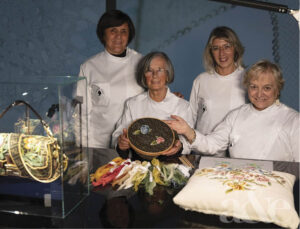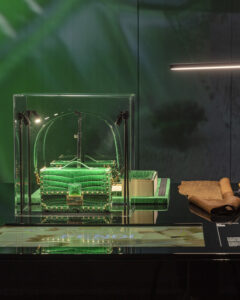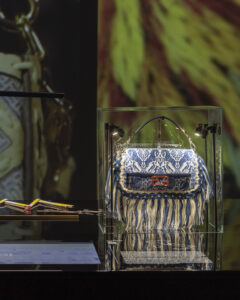Silvia Venturini Fendi, Artistic Director of Accessories and Menswear at Fendi discusses the brand’s latest initiative that honours the skills of Italian artisans.

This October, Fendi presented a unique art exhibition in Rome. “Hand in Hand” honoured the brand’s appreciation for Italian craftsmanship and highlighted the importance of preserving traditional crafts and supporting the few artisans that can implement these special skills today. Taking place inside the Palazzo della Civiltà Italiana in Rome, Hand In Hand showcased the brand’s partnership with local artisans across Italy who have implemented their own style on the iconic Fendi Baguette handbag. The initiative first began in 2020 as the brand partnered with artisans from around the country to transform this iconic accessory, designed by Artistic Director of Accessories and Menswear Silvia Venturini Fendi in their own way, showcasing their talents and skills. This unprecedented project showcases the time-honoured skills of craftspeople across Italy whose specialities in the applied arts continue FENDI’s long history of reinterpreting this iconic shape.

The exhibition in Rome showcased the work of this diverse group of ateliers and workshops, presenting their transformations of the classic Baguette and showcasing some of the crafts themselves. Twenty bags are on display, each handmade in a different Italian province in collaboration with the best local artisans. Floor-to-ceiling LED screens projected visions of the skilled artisans at work as they sketch designs, prepare materials, apply age-old techniques, and reveal the intergenerational secrets of their ancestral art. At the centre, each bag is displayed amongst the materials and tools used to create it. From weaving and embroidery to silversmithing, leather marquetry, lacework, tapestry, mosaic and more, 20 meticulous processes are revealed in a series of video documentaries embedded into each workstation, taking the viewer on a voyage across Italy and into family-owned workshops and craft collectives from around the country.
At the heart of the project is Fendi’s Artistic Director of Accessories and Menswear Silvia Venturini Fendi, who not only designed the Fendi Baguette in 1997 but has been supporting the use of traditional Italian crafts throughout her career. As a member of the Fendi family Silvia understands and appreciates the importance that these techniques have had at the brand since the beginning and with many of them dying out, she hopes that with Hand in Hand, Fendi can help to promote the value and importance of the Made In Italy concept. Here we discuss more about the project and the relevance of traditional craftsmanship today.

FENDI Baguette Hand in Hand exhibition – Calabria Artisan
Tell us about how the exhibition came to life and why did you call it Hand in Hand?
We often communicate on our products and the designers, but not so much on the people that are behind the creation of the objects, and with this initiative, I wanted to celebrate these incredible people. That’s why we called it “Hand in Hand” as it represents Fendi and the artisans coming together. I think that today, more than ever, people want to know what they are buying and wearing, how products are made, what they are paying for and the story behind it. I think we want to consume less, but better. And so sustainability and ethical issues are very important to today’s customers. It’s like when you eat, you look at what the ingredients are in your food, or if it’s organic etc. because you take into consideration your health, and I think the same thing applies to the products we wear and use. This is a way for brands to be transparent.
What is a lesson you have taken away from the experience of the global pandemic?
I think that today I’m more relaxed about things that used to be so important to me. Now I see everything from a different perspective. In a moment everything you believed in can change and you must reorder your values and priorities. So today I’m more flexible. Before I used to say “I have to have it, I need to go there”. Today, if it’s possible, I will, but otherwise, I can live without it.

FENDI Baguette Hand in Hand exhibition Umbria Artisan
To what extent do you think the “Made in Italy” concept is still relevant?
I believe that Italy is still the capital of craftsmanship. Made in Italy is a real value for us because it’s made up of many family-owned companies that have been keeping their skills alive for generations. Many other countries have lost their crafts and heritage for various reasons, but in Italy, it’s still alive, maybe not as it was before because the number of artisans is much less, but it is still there, and we need to recognise it.
In my generation we wanted our children to be lawyers, computer programmers, doctors, etc. and we thought that working in craftsmanship was something too humble, but that is not the case. And therefore, I want the artisans to be centre stage with this project.
We are expecting many people to visit over the next few weeks, including many young people, and I think that today more than ever, this is a profession for the future. To work with your hands and to be an artisan means that you can put a lot of yourself into an object, and today with the addition of the digital world, you can spread your message and amplify it. You could be an artisan in a small village in Italy, but your project can be seen all around the world. These artisans do incredible things and there is a real history behind it and I think it is a moment to show it.
Are you planning to take this as a travelling exhibition?
Yes, why not? It would be very nice, but the time of the artisans is also very precious, so it depends on them as they also need to continue with their production.

FENDI Baguette hand in hand exhibition – Molise Artisan
Is there a particular region of Italy that you connect with in terms of craftsmanship?
Every time I hear a story of craftsmanship it seems so unique, and I think it’s my favourite. Then I hear another story and I think that’s my favourite! It’s so difficult to choose one. At the moment, I have two regions from where I like: Umbria and Sardinia. Sardinia reminds me of my childhood because I went on a trip there with my grandparents when I was four or five years old. The bag the artisans from that region have created reminds me of a carpet my grandparents bought, so it brings back memories. And Umbria because I love the region and my paternal grandmother was from there. I have a house there which I go to very often and the Baguette they have created is so beautiful and I feel it’s something that shares a little of myself. I already ordered another bag: the one from Valle d’Aosta, because I think it will be nice to have when I go to the mountains, and I ordered one from Calabria because the story is so beautiful, and I know that I will wear it when I go to the country. It’s so moving to hear the processes and it makes me want to have them all!
Speaking of childhood, as a child did you have big dreams?
Yes as every child did. But what I knew was that I want to be part of this [Fendi], but then I had to compete with giants and try to prove and train myself, but it was worth it.

FENDI Baguette hand in hand exhibition – Lombardia bag
What is a challenge you have faced along the way and how did you overcome it?
For me, every day is a new challenge. When creating a collection, I have to deal with people in the world, changing their habits and I like to translate each moment into the products I create and the things I do. So for me, every collection is like the first. I like to have a very humble approach in everything I do.
What is something that you haven’t done yet that you still want to achieve at Fendi?
At any moment I have new ideas so I think I will always be looking to find new challenges. I have done a lot at Fendi but I am very curious to know one day what I can do without Fendi, this is something that I haven’t experienced yet! So, I do wonder what I will do one day if I have the time for myself? But at Fendi, I’ve done so much.

FENDI Baguette hand in hand exhibition – Umbria
Why do you think Fendi has been so successful at keeping a balance between the old and new generations of customers?
Maybe because we come from a family-owned company and we are used to dealing with multiple generations, maybe because this family attitude is still very much alive. I see it even in Kim Jones, the moment he arrived he was inspired by Delphina [Fendi], and he works closely with me, so he understands that you have to deal with different women of different ages and different generations which is something he immediately took into consideration when he joined the house. This is so important because today we want to be relevant, but we must be realistic, and I think that comes quite naturally here. Maybe it’s because this company has been modelled on a different range of women. For many years I have been working with my mother and listening to her but also working with my daughter and listening to her and I think this is very important at Fendi.
What is the message you would like to send to your clients in the Middle East?
I would like to say that I think they can appreciate the creations in this exhibition because the Middle East has an incredible heritage and I think that it’s important that to keep that DNA alive and not conform. When I visit the region, I want to see the culture and I think what the Middle East and the UAE is doing is amazing.















